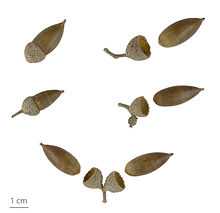Quercus ilex
| Holm oak | |
|---|---|
 | |
| Scientific classification | |
| Kingdom: | Plantae |
| (unranked): | Angiosperms |
| (unranked): | Eudicots |
| (unranked): | Rosids |
| Order: | Fagales |
| Family: | Fagaceae |
| Genus: | Quercus |
| Section: | Quercus |
| Species: | Q. ilex |
| Binomial name | |
| Quercus ilex L. | |
Quercus ilex, the holm oak or holly oak is a large evergreen oak native to the Mediterranean region. It takes its name from holm, an ancient name for holly.[1] It is a member of the white oak section of the genus, with acorns that mature in a single summer. It was first introduced to the United Kingdom in the 16th century. The first trees to be planted from acorns into England are still to be found growing within the stately grounds of Mamhead Park, Devon. They are uncommonly fine examples; several of these trees are 3 m (10 ft) in circumference at 1 m (3 ft) from the ground, and one of them measures 4 m (13 ft 6 in) in circumference.[citation needed]
Description


Quercus ilex is a medium-sized tree 20–27 metres (66–89 ft) tall with finely square-fissured blackish bark and leathery evergreen leaves. The old leaves fall 1–2 years after new leaves emerge. The leaves are dark green above and pale whitish-grey with dense short hairs below. The leaf shape is variable, the adult leaves are entire, 4–8 centimetres (1.6–3.1 in) long and 1–3 cm (0.39–1.18 in) broad, while those on the lower branches of young trees are often larger (to 10 cm or 3.9 in long), and are toothed or somewhat spiny – possibly as protection from grazing animals. In this, the foliage resembles that of the common European Holly Ilex aquifolium, and this resemblance has led to its common and botanic names. The name ilex is originally the classical Latin name for the Holm Oak, but was later also used as a botanical genus name for the hollies. The flowers are catkins, produced in the spring; the fruit is an acorn, which matures in about six months.
Subspecies
There are two subspecies:
- Quercus ilex subsp. ilex. Native in the north and east of the species' range, from northern Iberia and France east to Greece. Leaves narrow; acorns 2 cm long, bitter tasting.
- Quercus ilex subsp. rotundifolia (syn. Q. rotundifolia, Q. ballota). Native in the southwest of the species' range, in central and southern Iberia (Portugal and Spain) and northwest Africa. Leaves broader; acorns 2.5 cm long, sweet tasting.
Ecology
Holm Oak grows in pure stands or mixed forest in relatively arid climates and often at low or moderate elevations. One of the plant associations in which Holm Oak is found is the Holm Oak/Atlas Cedar forests of the Atlas Mountains. In Morocco, some of these mixed forests are habitat to the endangered primate, Barbary Macaque, Macaca sylvanus.[2]
Holm oak is damaging biodiversity in the United Kingdom, and is listed as an alien invader. Normally the tree is unable to withstand frost, which would prevent it from spreading north, but with climate change, it has successfully penetrated these areas.[3]
Cultivation and uses

The wood is hard and tough, and has been used since ancient times for general construction purposes as pillars, tools, wagons (Hesiod, Works and Days 429), vessels, and wine casks. It is also used as firewood, or in charcoal manufacture.
The Holm Oak is one of the top three trees used in the establishment of truffle orchards, or truffières. Truffles grow in an ectomycorrhizal association with the tree's roots.
The acorns, like those of the Cork Oak, are edible (toasted or as a flour), and are an important food for free-range pigs reared for ibérico ham production. Boiled in water, the acorns can also be used as a medicinal treatment for injury dis-infections.
It can be clipped to form a tall hedge, and it is suitable for coastal windbreaks, in any well drained soil. It forms a picturesque rounded head, with pendulous low-hanging branches. Its size and solid evergreen character gives it an imposing architectural presence that makes it valuable in many urban and garden settings. While Holm Oak can be grown in much of maritime northwestern Europe, it is not tolerant of cold continental winters.
References
| Wikimedia Commons has media related to Quercus ilex. |
- BBC News (2008) Holm Oak: Garden Invader
- Royal Botanic Garden (2008) Flora Europaea: Quercus ilex
- W.J. Bean (1976) Trees and shrubs hardy in the British Isles 8th ed., revised. John Murray.
- C. Michael Hogan (2008) Barbary Macaque: Macaca sylvanus, Globaltwitcher.com, ed. N. Strõmberg
- Holm Oak (2002)
- K. Rushforth (1999) Trees of Britain and Europe. HarperCollins ISBN 0-00-220013-9.
- (French)Chênes: Quercus ilex